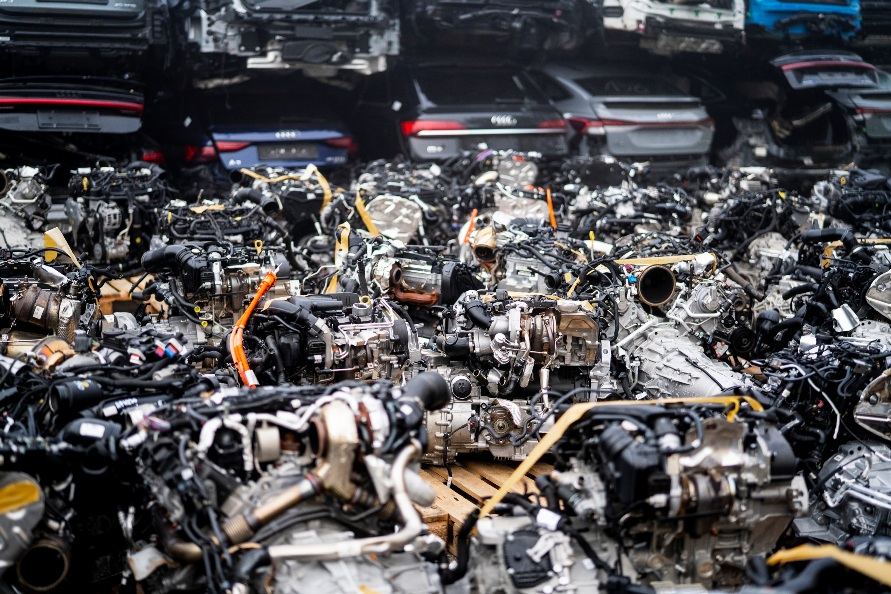Audi’s MaterialLoop project tests the circular economy potential of end-of-life vehicles
With its joint MaterialLoop project, Audi is taking the next step toward closing more material cycles in the automotive industry. Together with 15 partners from the research, recycling and supplier sectors, the company is looking into the re-use of so-called post-consumer materials, which are taken from customer vehicles at the end of their lifecycle, from the automotive sector for the production of new cars. As part of Audi’s circular economy strategy, the project provides valuable insight into how a circular economy can be put into practice.
Up to now, very few of the materials used in the production of new vehicles are recovered from old cars. Steel, for example, usually ends up as structural steel. Audi wants to change that by re-using secondary materials in the production of new cars. Downcycling, which is a loss of quality in materials resulting from the recycling process, is to be avoided.
“The MaterialLoop project underscores our ambitious plan to operate a highly efficient circular economy concept for end-of-life vehicles,” says Audi CEO Markus Duesmann. “It is our goal to recover as many materials as possible at a high level of quality and re-use them in production. This will save valuable primary materials and lower the products’ ecological footprint. Simultaneously, direct access to secondary materials can contribute to increased security of supply. Raw materials would no longer have to be extracted.”
In October 2022, 100 vehicles, including former development cars, were dismantled as part of the project. The targeted disassembly of individual components alone enabled the retention of high-quality secondary materials such as larger plastic pieces for recycling. After disassembly, the remaining car bodies were shredded and sorted into material groups comprising steel, aluminium, plastic and glass. To test the re-use of such materials in the production of new cars, Audi defined and piloted the further recycling process together with project partners from the recycling industry, the Audi supply chain, and academia.
“Our emphasis on cycles within the industry enables us to use our products and the materials they’re made from for as long as possible. Our vision is to rely less on secondary materials from other industries in the future”, explains Johanna Klewitz, head of supply chain sustainability at Audi.
Besides the technical feasibility of returning materials in the Audi supply chain, improving future generations of Audi vehicles’ ability to be recycled is also in focus. Dennis Meinen, expert for circular economy at Audi says, “At its core, the circular economy is about handling resources responsibly. Longevity, repairability and, indeed, our products’ ability to be recycled are thus all in focus.”
Recycled Audi A4 steel
The pilot project will run until the end of April. Despite this, Audi has already been able to put valuable findings from the MaterialLoop project into practice, with some materials now being fed back into automobile production. One result is that much of the scrap steel recycled in the project can be used to make new models. In an initial trial, six steel coils, made from about 12 percent secondary MaterialLoop materials, were produced that match Audi’s high standards for quality and can be used for the most demanding structural components. Audi plans to use the coils to produce up to 15,000 inner door parts for the Audi A4 at the Ingolstadt press plant. Moreover, research undertaken as part of the project, the portion of recycled steel from vehicles in the coil can actually be increased further.
Also, the company is gaining valuable information for the design and construction of future models. Besides improvements in sorting technology, “design for circularity” plays a decisive role in Audi’s efforts to optimise the recyclability of new generations of cars. This means that, as far as the material selection, composition and modularity are concerned, automotive parts and their components are to be designed in such a way that they can be sorted by material type during end-of-life recycling. As an additional result of the pilot project, Audi has developed a guide for suppliers that explains how plastic parts can be designed in a way that further increases the rate of recycling in automotive production.
Other materials
Audi has also begun gathering knowledge on the recycling of used automotive glass. Car windows that are beyond repair are first broken up into small pieces and then sorted. The resulting glass granulate is melted down and turned into new plate glass for the automotive industry – in fact, it is already used in the production of the Q4 e‑tron.
The company is also involved in plastics recycling. Thanks to PlasticLoop, one of the brand’s three plastics recycling projects, Audi and plastics manufacturer LyondellBasell have established a process that employs chemical recycling for the first time to reuse mixed automotive plastic waste for the series production of the Audi Q8 e-tron.
Since 2017, the resource aluminium is managed within a recycling circle at the Audi sites Ingolstadt, Neckarsulm, and Győr as well as at the Volkswagen site Bratislava. Aluminium offcuts which occur during production are returned directly to the supplier. There, they are recycled to form aluminium sheets of the same quality which Audi then reuses in production. This saves precious primary raw materials and ensures the cars enter the use-phase with a better environmental balance.
- UK manufacturing steps up to COVID-19 crisis - April 2, 2020
- Clustering Innovation - March 12, 2020
- A Global Monitor - March 6, 2020

